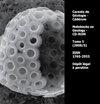中新世须鲸半径上的鱼种Linichnus bromleyi保留了多个鲨鱼咬摇痕迹,表明它们是食腐动物
IF 1.5
4区 地球科学
Q2 GEOLOGY
引用次数: 5
摘要
一条孤立的中新世须鲸的左桡骨上反复出现鲨鱼咬摇的痕迹。该半径可能来自美国马里兰州卡尔弗特县卡尔弗特悬崖卡尔弗特组梅点段。至少有三个连续的多颗牙齿咬摇痕迹,标志着该半径属于痕迹化石Linichnus bromleyi。这些咬摇痕迹由半径上的浅而薄的拱状凹痕组成,可能表明它们是食腐动物,而不是主动捕食动物。最有可能在三组痕迹中的每一组中产生L. bromleyi束的方法是,当鲨鱼重新定位猎物在嘴里的位置时,通过反复撕咬,或者可能是一种在牙齿排中有多颗功能牙齿的鲨鱼物种。如果咬痕是由一颗无锯齿的牙齿留下的(就像它们看起来的那样),那么最有可能的候选人就是hastalis Carcharodon。本文章由计算机程序翻译,如有差异,请以英文原文为准。
The ichnospecies Linichnus bromleyi on a Miocene baleen whale radius preserving multiple shark bite-shake traces suggests scavenging
An isolated Miocene baleen whale left radius was marked repeatedly by shark bite-shake traces. The radius probably derives from the Plum Point Member of the Calvert Formation, Calvert Cliffs, Calvert County, Maryland, U.S.A. At least three successive bite-shake traces, made by multiple teeth, marking the radius are attributed to the trace fossil Linichnus bromleyi. These bite-shake trace consisting of shallow, thin arching gouges on a radius, likely indicates scavenging rather than active predation. The most likely means of producing the bundle of L. bromleyi within each of the three sets of traces would be through repeated biting as the shark re-positioned the prey in its mouth or, perhaps, by a shark species with multiple functional teeth within its tooth row. If the bite traces were produced by a non-serrated tooth (as they appear to have been), then the most likely candidate would be Carcharodon hastalis.
求助全文
通过发布文献求助,成功后即可免费获取论文全文。
去求助
来源期刊

Carnets De Geologie
Earth and Planetary Sciences-Geology
CiteScore
2.90
自引率
14.30%
发文量
21
审稿时长
>12 weeks
期刊介绍:
Information not localized
 求助内容:
求助内容: 应助结果提醒方式:
应助结果提醒方式:


